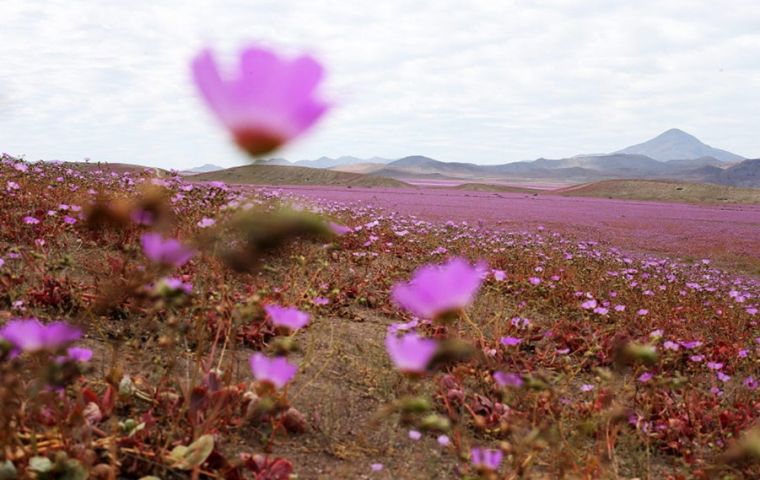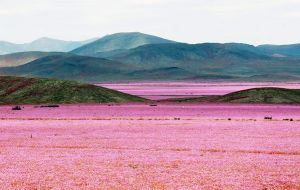MercoPress. South Atlantic News Agency
El Niño turns the world's most arid desert into a blossomed carpet
 The softer side to the disruptive El Niño: an enormous blanket of colorful flowers has carpeted Chile's Atacama desert, the most arid in the world.
The softer side to the disruptive El Niño: an enormous blanket of colorful flowers has carpeted Chile's Atacama desert, the most arid in the world.  The cyclical warming of the central Pacific may be causing droughts and floods, but in the vast desert of north Chile it has caused a vibrant explosion of flowers
The cyclical warming of the central Pacific may be causing droughts and floods, but in the vast desert of north Chile it has caused a vibrant explosion of flowers One of the driest places on Earth has blossomed after some unusual rain earlier this year. The Atacama Desert, primarily located in Chile along the Pacific Ocean, is flush with flowers after relatively heavy precipitation in March and August fell in the drought-stricken region.
The bloom generally occurs once every five to seven years, but rain in March and more in August has produced an array of blooms reportedly not seen in such profusion in nearly two decades.
The rainfall on one day in March, between 30 and 50 mm, was the equivalent of approximately 14 years of precipitation, according to The Washington Post.
More than 25 people were killed and thousands left homeless after the March rain, which caused mudslides and flooding.
Daniel Diaz, the director of the National Tourism Service in Atacama said that “the region was punished, but also blessed by the phenomenon of a flourishing desert, something that happens only after the rains, this time brought about by El Niño and climate change”.
“The intensity of blooms this year has no precedent, and the fact that it has happened twice in a same year has never been recorded in the country's history. We are most surprised”.
The desert once went more than 14 years without rain in the early 20th century, according to Arizona State University's School of Geographical Sciences and if you would like to see of more than 200 native plant species in person, “you'll have to get to Chile quickly, as the bloom will soon end”.




Top Comments
Disclaimer & comment rules-

-

-

Read all commentsA fantastic and stunningly beautiful transformation.
Oct 31st, 2015 - 10:43 am 0Not a wonder we have had such a bad spring.
Oct 31st, 2015 - 12:26 pm 0“this time brought about by El Niño and climate change”.”
Oct 31st, 2015 - 03:02 pm 0The obligatory reference to “climate change”. Mention of El Nino was sufficient.
Commenting for this story is now closed.
If you have a Facebook account, become a fan and comment on our Facebook Page!